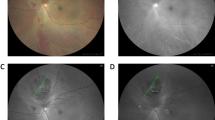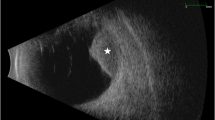Abstract
Background
The purpose of this work was to compare the detection of ultrasonographic hollowness (UH), as a risk sign for evolution from small choroidal melanocytic tumors (SCMT) to uveal melanoma (UM), between conventional ultrasonography (standardized 8 MHz ultrasonography and B-mode 10 MHz ultrasonography) and high-resolution 20 MHz ultrasonography.
Methods
Fifty SCMTs from 50 eyes were included in this work. In all cases, ultrasonographic studies were performed using: 8 MHz standardized A-mode, 10 MHz B-mode, and posterior pole 20 MHz B-mode. Comparison between the presence and the absence of UH were carried out between the ultrasonographic images.
Results
There were no statistically significant differences between the SCMT dimensions obtained using the 8–10 and 20 MHz techniques. UH was detected in 12 and 20 cases by means of ten and 20 MHz probes respectively. The difference between these proportions was statistically different from zero (McNemar test, p-value = 0.008). Cases without UH by 20 MHz have lower height values than cases with UH. However, these differences were not found by 10 MHz ultrasonography. By receiver operating characteristic (ROC) study, specificity was better by 20 MHz than 10 MHz ultrasonography when the value of tumor height as marker for UH was studied.
Conclusions
UH is easier to detect by 20 MHz than by 10 MHz ultrasonography. This ultrasonographic sign appears to be correlated with the height of the tumor. Thus, we believe UH estimation by 20 MHz ultrasonography could be used as a significant predictive factor for SCMT growth.




Similar content being viewed by others
References
Collaborative Ocular Melanoma Study Group (2006) Twelve-year mortality rates and prognostic factors. Randomized trial of iodine 125 brachytherapy for choroidal melanoma. COMS report no. 28. Arch Ophthalmol 124:1684–1693
Diener-West M, Reynolds SM, Agugliaro DJ et al (2005) Development of metastatic disease after enrollment in the COMS trials for treatment of choroidal melanoma: Collaborative Ocular Melanoma Study Group, report no. 26. Arch Ophthalmol 123:1639–1643
Augsburger JJ, Schroeder RP, Territo C et al (1989) Clinical parameters predictive of enlargement of melanocytic lesions. Br J Ophthalmol 73:911–917
Shields CL, Shields JA, Kiratli H et al (1995) Risk factors for growth and metastasis of small choroidal melanocytic lesions. Ophthalmology 102:1351–1361
Shields CL, Cater J, Shields JA et al (2000) Combination of clinical factors predictive of growth of small choroidal melanocytic tumors. Arch Ophthalmol 118:360–364
Shields CL, Furuta M, Berman EL et al (2009) Choroidal nevus transformation into melanoma: analysis of 2514 consecutive cases. Arch Ophthalmol 127:981–987
Collaborative Ocular Melanoma Study Group (1997) Factors predictive of growth and treatment of small choroidal melanoma. COMS report no. 5. Arch Ophthalmol 115:1537–1544
Singh AD, Kalyani P, Topham A (2005) Estimating the risk of malignant transformation of a choroidal nevus. Ophthalmology 112:1784–1789
Singh AD, Mokashi AA, Bena JF, Jacques R, Rundle PA, Rennie IG (2006) Small choroidal melanocytic lesions: features predictive of growth. Ophthalmology 113:1032–1039
Ossoinig KC, Lohmeyer M (1990) Choroidal nevi: diagnosis with standardized echography. In: Sampaolesi R (ed) Ultrasonography in ophthalmology, 12th edn. Kluwer, Dordrecht, p 173
Minning CA Jr, Davidrof FH (1982) Ossoinig’s angle of ultrasonic absorption and its role in the diagnosis of malignant melanoma. Ann Ophthalmol 14:564–568
Collaborative Ocular Melanoma Study Group (2003) Comparison of clinical, echographic, and histopathological measurements from eyes with medium-sized choroidal melanoma in the Collaborative Ocular Melanoma Study. COMS report no. 21. Arch Ophthalmol 121:1163–1171
Byrne SF, Marsh MJ, Boldt HC, Green RL, Johnson RN, Wilson DJ (2002) Consistency of observations from echograms made centrally in the Collaborative Ocular Melanoma Study. Ophthalmic Epidemiol 9:11–27
Collaborative Ocular Melanoma Study (1999) Echography (ultrasound) procedures for the Collaborative Ocular Melanoma Study (COMS), report no. 12, part II. J Ophthalmic Nurs Technol 18:219–232
Collaborative Ocular Melanoma Study (1999) Echography (ultrasound) procedures for the Collaborative Ocular Melanoma Study (COMS), report no. 12, part I. J Ophthalmic Nurs Technol 18:143–149
Berson M, Grégoire JM, Gens F et al (1999) High frequency (20 MHz) ultrasonic devices: advantages and applications. Eur J Ultrasound 10:53–63
Hewick SA, Fairhead AC, Culy JC, Atta HR (2004) A comparison of 10 MHz and 20 MHz ultrasound probes in imaging the eye and orbit. Br J Ophthalmol 88:551–555
Coleman DJ, Silverman RH, Chabi A et al (2004) High-resolution ultrasonic imaging of the posterior segment. Ophthalmology 111:1344–1351
Ossoinig KC (1979) Standardized echography: basic principles, clinical applications, and results. Int Ophthalmol Clin 19:127–210
Ossoinig KC, Bigar F, Kaefring SL (1975) Malignant melanoma of the choroid and ciliary body: a differential diagnosis in clinical echography. Bibl Ophthalmol 83:141–154
Bland JM, Altman DG (1986) Statistical methods for assessing agreement between two methods of clinical measurement. Lancet 1:307–310
R Core Team. R: a language and environment for statistical computing. R Foundation for Statistical Computing. Vienna, Austria. URL: http://www.R-project.org/. Accessed 15 Jan 2014
Frazier Byrne S, Green RL (2002) Intraocular tumors. In: Frazier Byrne S, Green RL (eds) Ultrasound of the eye and orbit, 2nd edn. Mosby, St. Louis, pp 115–190
Kook D, Kreutzer TC, Wolf A, Haritoglou C (2011) Variability of standardized echographic ultrasound using 10 MHz and high-resolution 20 MHz B scan in measuring intraocular melanoma. Clin Ophthalmol 5:477–482
Goldberg MF, Hodes BL (1977) Ultrasonographic diagnosis of choroidal malignant melanoma. Surv Ophthalmol 22:29–40
Conflict of interest
All authors certify that they have NO affiliations with or involvement in any organization or entity with any financial interest (such as honoraria; educational grants; participation in speakers’ bureaus; membership, employment, consultancies, stock ownership, or other equity interest; and expert testimony or patent-licensing arrangements), or non-financial interest (such as personal or professional relationships, affiliations, knowledge or beliefs) in the subject matter or materials discussed in this manuscript.
Author information
Authors and Affiliations
Corresponding author
Rights and permissions
About this article
Cite this article
Piñeiro-Ces, A., Rodríguez Alvarez, M.J., Santiago, M. et al. Detecting ultrasonographic hollowness in small choroidal melanocytic tumors using 10 MHz and 20 MHz ultrasonography: a comparative study. Graefes Arch Clin Exp Ophthalmol 252, 2005–2011 (2014). https://doi.org/10.1007/s00417-014-2758-4
Received:
Revised:
Accepted:
Published:
Issue Date:
DOI: https://doi.org/10.1007/s00417-014-2758-4




